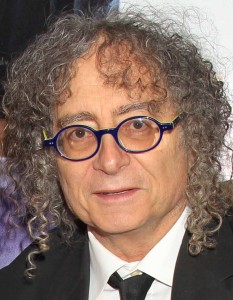
“I’m so lucky that Adam was the director,” stated editor Hank Corbin about Adam McKay, who helmed The Big Short, the satiric-telling of the true events behind the financial collapse in the mid-2000s. The movie boasts a stellar acting ensemble – Christian Bale, Steve Carell, Ryan Gosling and Brad Pitt.
According to Corwin, the script was “unbelievable.” The editor and director were “hitting it off” on the phone, but Corwin confessed, “I don’t do comedy. Nobody’s ever asked me to do comedy. I do Terrence Malick movies. He said, ‘Don’t worry. Do what you do. I’ve got the comedy covered.’ And he did! I really wonder if another director had done this, how it would have come out.”
Although the script was well written, it contained a lot of financial “jargon” and a large cast of characters, which could be hard for the audience to follow. Interwoven into the film were four story lines, told through the perspectives of the four outsiders who predicted the turmoil. Corwin approached the complex story structure by giving each of the four characters their own editorial style.
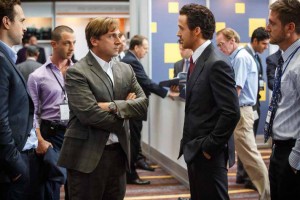
Corwin related the most to Bale’s character, Michael Burry, who he felt was the heart of the movie. He surmised that perhaps being an editor and used to sitting alone in dark rooms, he could understand being introverted. The cutting on Burry’s story was “very calm, and very peaceful, and very internal.”
Carell’s Mark Baum character was tortured and fiery. Corwin made the editing “literally bombastic.” He made jump cuts and some of them were deliberately ugly.
The Brad Pitt grouping had a naïve quality, with Pitt’s character, Ben, “sort of missing in action visually for a while.” Corwin attempted to make that editing almost invisible and very traditional.
As the stories converged and the film started resolving itself, Corwin noted, “All these disparate editorial styles sort of folded into one because they started taking the same path, the same journey.”
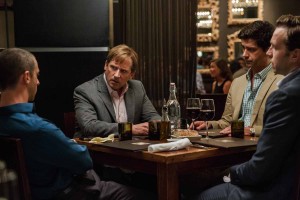 As a fan of history, Corwin recognized how chaotic that period was. The montages were not in the script, but rather they were created to contextualize the times. Using the technique of abruptly cutting out of the dialog served to propel the viewer into the next scene.
As a fan of history, Corwin recognized how chaotic that period was. The montages were not in the script, but rather they were created to contextualize the times. Using the technique of abruptly cutting out of the dialog served to propel the viewer into the next scene.
“There are so many ways to tell a story. I thought it would be great to be able to use images and music and just make the experience much fatter, much richer,” revealed Corwin.
Instead of having the characters be in their “masters-of-the-universe towers,” the montages presented them in relation to the world. Corwin wanted to show what the real stakes were, to humanize the story. These characters were not traditional heroes, or particularly likeable for that matter, rather they were “symptomatic of what was going on in the country.”
Choices like the Ludacris video of Shake your Money Makers, moved the momentum of the scene forward because of the peppy pace of the music, but the touted values of the song were “horrifying” to Corwin. “It’s easy to blame the base. It’s easy to blame the bankers, but it’s more of a societal issue,” declared Corwin.
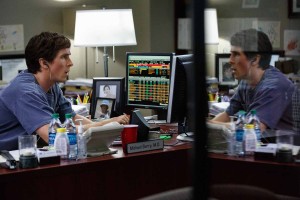 Corwin believes that people do not think long term, so the fact that these guys were shorting the economy was more of a game to them. It came as a shock to Jamie (Finn Wittrock) and Charlie (John Magaro) when Ben tells them to stop dancing because they are screwing the whole world. What was really happening had to be explained to these guys in the financial industry, so it is no small wonder that average people still do not fully comprehend what happened.
Corwin believes that people do not think long term, so the fact that these guys were shorting the economy was more of a game to them. It came as a shock to Jamie (Finn Wittrock) and Charlie (John Magaro) when Ben tells them to stop dancing because they are screwing the whole world. What was really happening had to be explained to these guys in the financial industry, so it is no small wonder that average people still do not fully comprehend what happened.
Another device used in the film was the moment when Gosling’s Jared Vennett character breaks the fourth wall and directly addresses the viewer. These “splaners” were used to clarify the complex financial dealings, even if it meant stopping the action of the film to explain something. Corwin admitted that these explanations personally helped him to understand the anatomy of the crisis.
The editor had a lot of great performances to work with, but each of the actors had their own way of working. Bale came to the part “utterly prepared. He was the character.”
Carell came from an improv background. Especially in the beginning of the film when he was trying to discover his character, the editor had many different performances and loads of improv in the takes. Corwin wanted to avoid having the performance feel too polished.
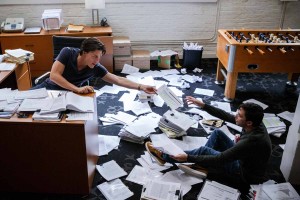 “What was really interesting and really great, is that I was able to use the mistakes. Like when Carell is reaching for something and can’t quite hit it, and just starts looking off into space. These are really human moments,” said Corwin. “Mistakes are my friend. I am always looking for anything to make the film feel more experiential, like you are in the room with them as opposed to just watching them.”
“What was really interesting and really great, is that I was able to use the mistakes. Like when Carell is reaching for something and can’t quite hit it, and just starts looking off into space. These are really human moments,” said Corwin. “Mistakes are my friend. I am always looking for anything to make the film feel more experiential, like you are in the room with them as opposed to just watching them.”
McKay orchestrated the collaboration between editorial and composer Nicholas Britell, who came onto the production early. With his office across from the edit room, he could come in and hook up his keyboard to the edit system and compose along with the cut. “He was part of it right from the beginning and I loved working that way,” said Corwin.
Corwin had a very short post schedule, but despite the compressed time frame, once he knew what he wanted to do with the film and started cutting, it was easy. The hardest part was screening the dailies because the footage presented so many possibilities. The editor spent hours and hours looking at scenes and taking books of notes.
“It’s the way I learn,” said Corwin. “That part of the process was very tough for me because there were so many variations. Adam was always fishing with improv.”
Despite being shot on film, tons of footage was captured, so sorting through all the performances was daunting. The editor noted that every take was good. Every take had something special. “When you have actors at this level, so many of their performances are right on the money,” stated Corwin. “You just have to decide whether it’s the right currency.”





